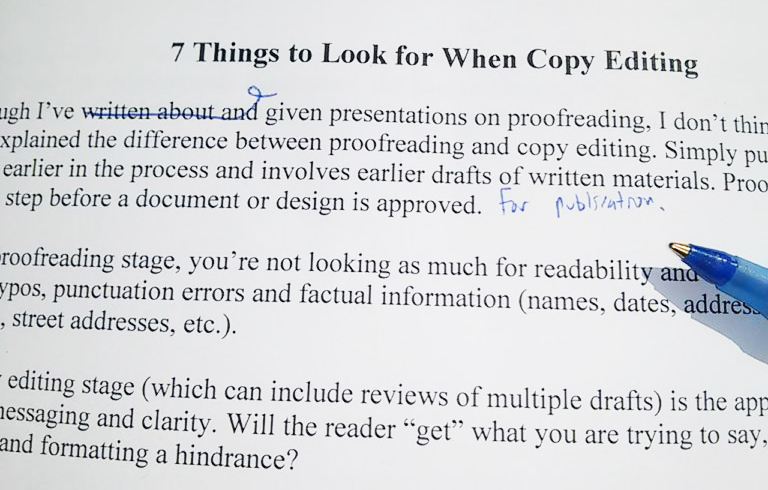7 things to look for when copy editing
- May 10, 2017
- Author: Glenn Gillen, APR
- Category: Communication, Writing

Although I’ve given presentations on proofreading, I don’t think I’ve ever fully explained the difference between proofreading and copy editing. Simply put, copy editing occurs earlier in the process and involves earlier drafts of written materials. Proofreading is often the last step before a document or design is approved for publication.
At the proofreading stage, you’re not looking as much for readability and comprehension as you are for typos, punctuation errors and factual information (names, dates, addresses, URLs, street addresses, etc.).
The copy editing stage (which can include reviews of multiple drafts) is the appropriate time to address messaging and clarity. Will the reader “get” what you are trying to say, or is your language and formatting a hindrance?
Here are seven things I look for when copy editing a written document:
1. Run-on sentences – You know, the ones that go on and on, and don’t seem to end despite the fact that your reader is getting confused and doesn’t know where you’re going, even though you think it’s perfectly clear, and that it’s the reader’s fault if he or she can’t follow your train of thought because, obviously, you’re a brilliant writer. Yeah, cut those out.
2. Long paragraphs – Big blocks of text convey the unintended message: “I dare you to read me!” Break them up to create a more readable document. Grammarians disagree on ideal paragraph length (three to five sentences, four to six, etc.) but journalistic writing generally includes shorter paragraphs (one to three sentences). Good writers vary paragraph length to break up the monotony.
3. Odd phrasing – Aim for brevity and clarity of thought. “He is the one to whom I am engaged” might work for a Victorian novel. “He’s my fiancé” says the same thing more succinctly.
4. Passive voice – “The results were given to me by my professor.” Meh. “My professor gave me the results.” Better.
5. Verb-subject agreement – Make sure singular subjects take singular verbs, and plural subjects take plural verbs. Watch for sentences like “One of the committee members is going to abstain” where the subject is “one” (singular) and not “members” (plural).
6. Misplaced modifiers – These are adjectives, phrases or clauses that appear to modify an unintended word. For example, “Charging toward him, Thomas was frightened by the goose.” Was the goose charging or was Thomas? I would rewrite this. Also note the passive voice in this example.
7. Jargon and acronyms – When writing for general audiences, limit the use of jargon and obscure acronyms. You can relax this rule a little when writing for very specific audiences.
While these aren’t the only things to look for when copy editing, they provide a good foundation. Remember, the goal of effective communications is to get your audience to understand exactly what it is you want them to know.
